The serial cap is to reduce the peak and extend the bass and it does work. But that is for a box Q of 1.0-1.1
Ah, that makes sense. It would be hard to get the QTS that high, due to the very high BL and the relatively light cone and surround in the Summa.
For my current project, that might be worth looking into, as the specs are quite different. Here's a comparison of the woofer in the Summa versus the woofer I'm using in Monster Massive.
woofer: B&C 15TBX100 / Diyma R12
qms: 5.2 / 4.0
qes: 0.3 / 0.47
qts: 0.28 / 0.57
vas: 107.6L / 42L
fs: 35hz / 27.6hz
Last edited:
Hey Patrick......ever consider 4 dome midranges for use in a synergy type system? The Dayton RS52 in quads woulds provide enough efficiency and could go as low as 500hz without strain. Just something to consider. It would be interesting to create a throat for the CD using the domes to form it.......could be similiar in function to JBL's new guides used in the M2. Being forced due to costs to work with fiberglass, epoxy and resins on my boat, ive been pretty impressed with what is possible with this stuff and some creative thinking.
Hey Patrick......ever consider 4 dome midranges for use in a synergy type system? The Dayton RS52 in quads woulds provide enough efficiency and could go as low as 500hz without strain. Just something to consider. It would be interesting to create a throat for the CD using the domes to form it.......could be similiar in function to JBL's new guides used in the M2. Being forced due to costs to work with fiberglass, epoxy and resins on my boat, ive been pretty impressed with what is possible with this stuff and some creative thinking.
Indeed! I have four of them here, and I gave them a try. They work well. There are only a couple of drawbacks:
1) they basically have no surround, so their excursion is virtually nil. This limits the SPL of the entire system, and also the dynamics.
2) I would personally recommend reducing the back chamber. You can do this by sawing the driver in half. (The chamber is plastic, which makes it easy to reduce.)
Once you reduce the back chamber, it increases the efficiency by narrowing the bandwidth of the driver. That helps offset the lack of SPL.
Having said all that, the ND91 has a lot in common with the RS52, but with more output:
1) The ND91 and the RS52 both have an aluminum dome that's similar in size
2) Both drivers have a copper shorting ring to reduce distortion
The system is coming along nicely.
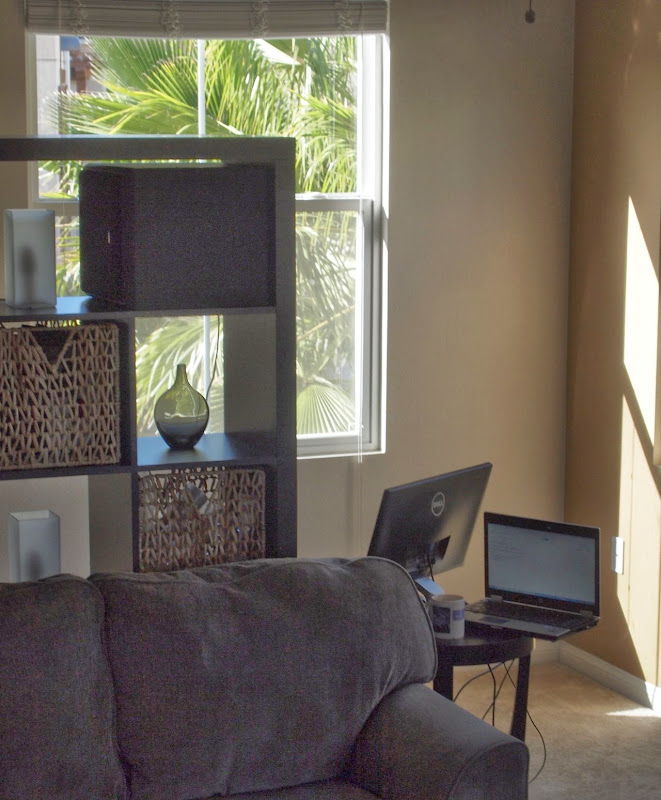
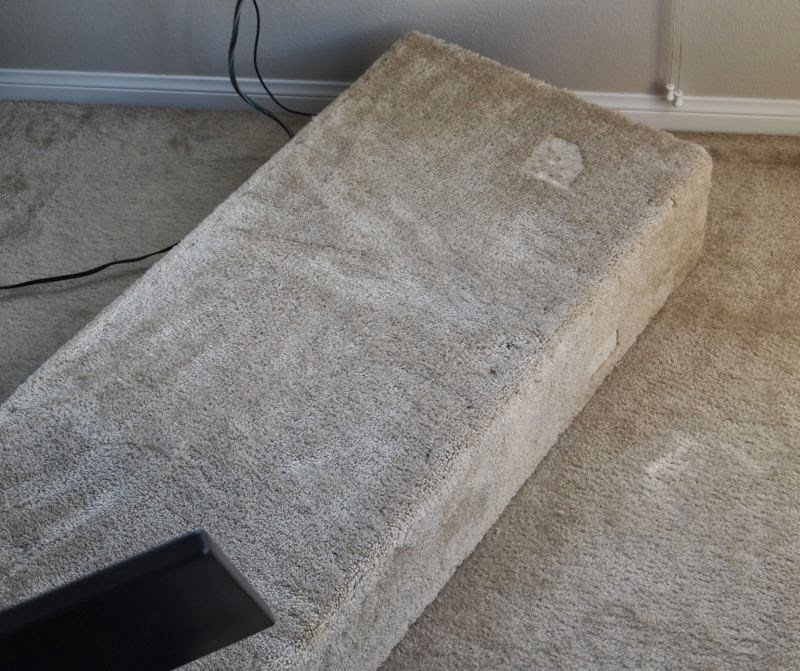
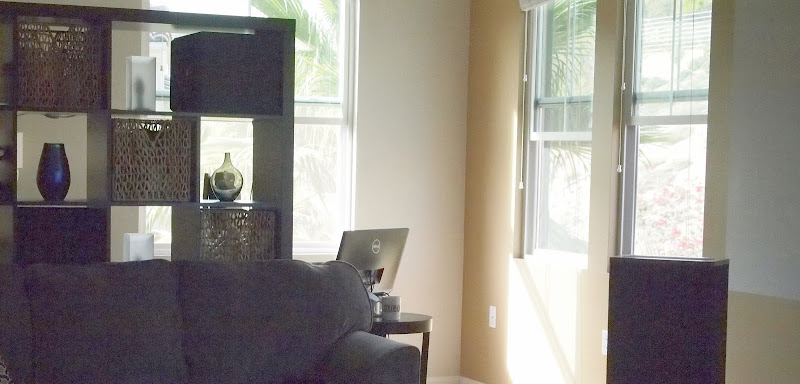
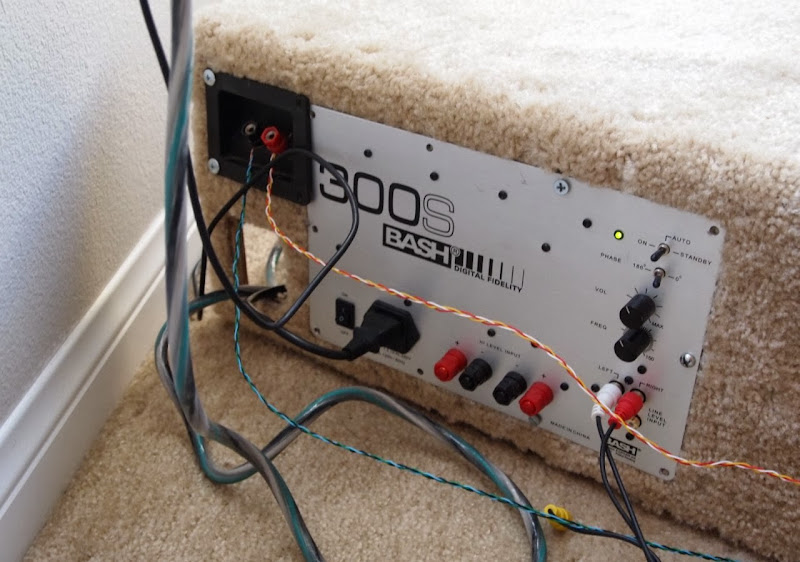
Probably the main goal for this project is to reduce the footprint of my reference speakers. (Gedlee Summas.) In order to get some bass, I'm using multiple subs, distribute throughout the room. Here's some pics of how it's coming along. There are currently three subwoofers:
1) A Kef vented sub that's up on my Ikea shelf (up on the top right.)
2) A bandpass sonotube sub, that's over in the opposite corner.
3) Possibly the most interesting sub is a dual 8" tapped horn, loosely based on the TH-Spud and Mike's Insubnia.
The tapped horn sits on the floor, and I have my chair on top of it. So it's basically a platform that I sit on. It's hidden in the corner, and hard to see I think. Nearly all of the electronics are built into the tapped horn; this includes the miniDSP, the sub amp, and the mid and high frequency amp.




Probably the main goal for this project is to reduce the footprint of my reference speakers. (Gedlee Summas.) In order to get some bass, I'm using multiple subs, distribute throughout the room. Here's some pics of how it's coming along. There are currently three subwoofers:
1) A Kef vented sub that's up on my Ikea shelf (up on the top right.)
2) A bandpass sonotube sub, that's over in the opposite corner.
3) Possibly the most interesting sub is a dual 8" tapped horn, loosely based on the TH-Spud and Mike's Insubnia.
The tapped horn sits on the floor, and I have my chair on top of it. So it's basically a platform that I sit on. It's hidden in the corner, and hard to see I think. Nearly all of the electronics are built into the tapped horn; this includes the miniDSP, the sub amp, and the mid and high frequency amp.
How big is the dual 8" And how low does it go?
It's pretty big. About six and a half cubic feet.
It's designed to get loud, not low; I'd actually built it for my old Honda, with the intention of making a loud ol' horn for SPL type stuff. It's tuned at about 35hz, and the F3 is about the same.
But then I sold the car, so I moved the sub into my living room!
Details here: http://www.diyaudio.com/forums/subwoofers/192539-tapped-horn-lazy-impatient.html
Ah, that makes sense. It would be hard to get the QTS that high, due to the very high BL and the relatively light cone and surround in the Summa...
Are you referring to 15TBX100 ? What is "relatively light" in B&C 15TBX100 ?
It has Mms=163gr. It has one of the heaviest moving systems i've seen in 15" pro woofer - if we count out dedicated subwoofers that can't do anything beyond 300-400Hz.
Are you referring to 15TBX100 ? What is "relatively light" in B&C 15TBX100 ?
It has Mms=163gr. It has one of the heaviest moving systems i've seen in 15" pro woofer - if we count out dedicated subwoofers that can't do anything beyond 300-400Hz.
I mostly do car audio. In the world of car audio, a 15" with a 163gr cone is "light."
I don't have the mms spec of my TC Sounds fifteens handy, but it sure *looks* heavier than the 15TBX100. Foam surround versus accordion surround, aluminum cone versus treated paper cone. I quick look at Parts Express shows an MMS of 383g for the LMS-R 15" woofer from TC.
That is why i wrote "if we count out dedicated suwoofers". Compared to LMS-R15, 15TBX100 really is a lot lighter.
I am working on something similar to Summa's but with Beyma 15K200 and using DE250 for tweeter. Xover should be 24/18dB/o and at 900-1000 Hz. Beyma has Mms of 107gr and i think that even that is a lot to reproduce lower mids with proper dynamics.
I am working on something similar to Summa's but with Beyma 15K200 and using DE250 for tweeter. Xover should be 24/18dB/o and at 900-1000 Hz. Beyma has Mms of 107gr and i think that even that is a lot to reproduce lower mids with proper dynamics.
In the original post I was referring to the possibility of raising the QTS of the 15TBX100 by increasing QES and QMS. Basically it would be hard to get it up to 1.0 because it's hard to add enough weight or enough resistors to make it's parameters ideal for an OB.
But it's all a bit academic; with miniDSP you don't have to bother, just 'dial in' whatever frequency response you want and skip any driver modifications.
But it's all a bit academic; with miniDSP you don't have to bother, just 'dial in' whatever frequency response you want and skip any driver modifications.
Patrick,
Excellent write up on the Pyle horn unity. I like the idea of modifying an existing horn instead of having to build a horn from wood. if it works out that the measurements are OK with your project, I may use it to replace the tweeter and horn of my modified Klipsh Cornwall speakers. All I would need to do it simply seal the ends of the ND91's and cut a hole for the Pyle horn.
One neat thing about this project is that you could cut the mounts for the ND91's out of masonite and then simply glue it it using loctite "repair putty". We use this stuff all the time in industrial applications to hold up 2 pound brackets directly mounted to machines. Its and industrial epoxy that molds like clay and in 5 minutes, its has hard as a rock, bonding to nearly anything. JBweld makes a similar product, but has steel filler. Its available at walmart and home depot.
Nick McKinley of Lambda acoustics use to be based in my hometown of Melbourne, FL. I remeber going to his place one time to listen to the Unity speakers he built. I never heard anything quite like it!
Excellent write up on the Pyle horn unity. I like the idea of modifying an existing horn instead of having to build a horn from wood. if it works out that the measurements are OK with your project, I may use it to replace the tweeter and horn of my modified Klipsh Cornwall speakers. All I would need to do it simply seal the ends of the ND91's and cut a hole for the Pyle horn.
One neat thing about this project is that you could cut the mounts for the ND91's out of masonite and then simply glue it it using loctite "repair putty". We use this stuff all the time in industrial applications to hold up 2 pound brackets directly mounted to machines. Its and industrial epoxy that molds like clay and in 5 minutes, its has hard as a rock, bonding to nearly anything. JBweld makes a similar product, but has steel filler. Its available at walmart and home depot.
Nick McKinley of Lambda acoustics use to be based in my hometown of Melbourne, FL. I remeber going to his place one time to listen to the Unity speakers he built. I never heard anything quite like it!
This isn't equalized, but here's what it looks like at zero, 22.5 and 45 degrees off axis:
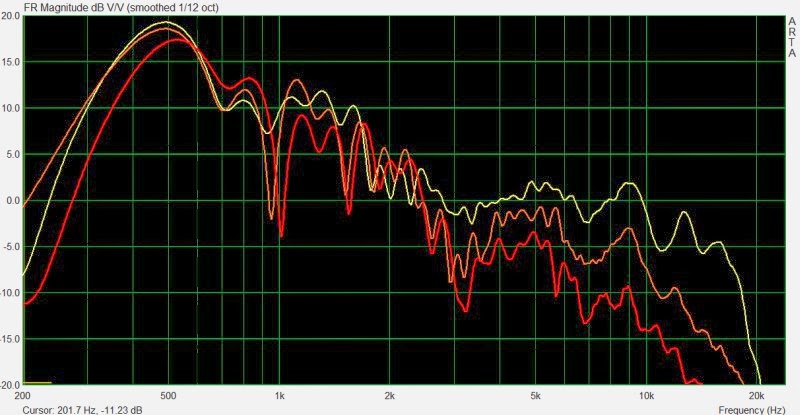
Basically we see that the beamwidth is narrowing at high frequency, just as expected.
Note that the vertical range in this measurement is compressed to 40dB to make the variations clearer. (The other measurements used a 50dB window.)
I'm kinda stoked that the dipole radiation doesn't seem to be creating and weird lobes off axis, with the possible exception of a dip at 1khz.
Obviously the response will change quite a bit once I add a baffle, and I plan to make it cardioid-ish also.
User DJK posted an interesting patent over in the 'study of dipole/cardiod horn' thread. Apparently Cerwin Vega had a patent on a Unity-style cardioid horn, almost fifteen years ago. (Patent US6038326 - Loudspeaker and horn with an additional transducer - Google Patents)
I believe it predates the SPL Labs Unity horn by a few years, and Danley references the Cerwin Vega patent in his patent.
Interesting stuff.

a second electroacoustic transducer disposed outside said compression chamber, said second electroacoustic transducer being mechanically and acoustically coupled to said horn whereby, when radiation of said second electroacoustic transducer is added to radiation of said first electroacoustic transducer, radiation output in front of said loudspeaker is a dipole and in phase augmentation sharing the monopath of the output of said first electroacoustic transducer and in rear of said loudspeaker is out of phase of with the output of said second electroacoustic transducer so that said combined monopole and dipole produces a cardiode-shaped wave.
But in the CV patent, throat and offset drivers cover the same frequency range, it is not a way to split up an audio band among drivers (more math needed for that).
It's complex:
In a horn with sealed back drivers, like a Synergy horn, the Fb of the midranges is somewhere around 500hz.
In a horn with open back drivers, like a back loaded horn, the Fb of the midranges is significantly lower. For instance, if you remove the back off of those sealed midranges, the Fs will drop to something like 150hz.
OK, so I've established that the same driver will have a different bandwidth depending on whether the chamber is on the driver.
Here's where things get tricky:
Removing the back chamber ALSO lowers the efficiency. For instance, a 5" midrange with a backchamber will have an Fb of around 500hz and an efficiency of about 95dB. Remove that backchamber and the FS goes down to about 150hz, but the efficiency also drops significantly; perhaps as low as 87dB or so.
Someone really needs to build one of these things, and I unintentionally came close when I built this:
(note that two of the midranges are dipole, and one is sealed.)
Due to the efficiency difference between the sealed midranges and the dipole midranges, I think you need about 3-4 times as many dipole midranges. But the geometry of a Synergy horn is well suited to this setup; you could have three midranges that are open back, and one midrange that's closed back.
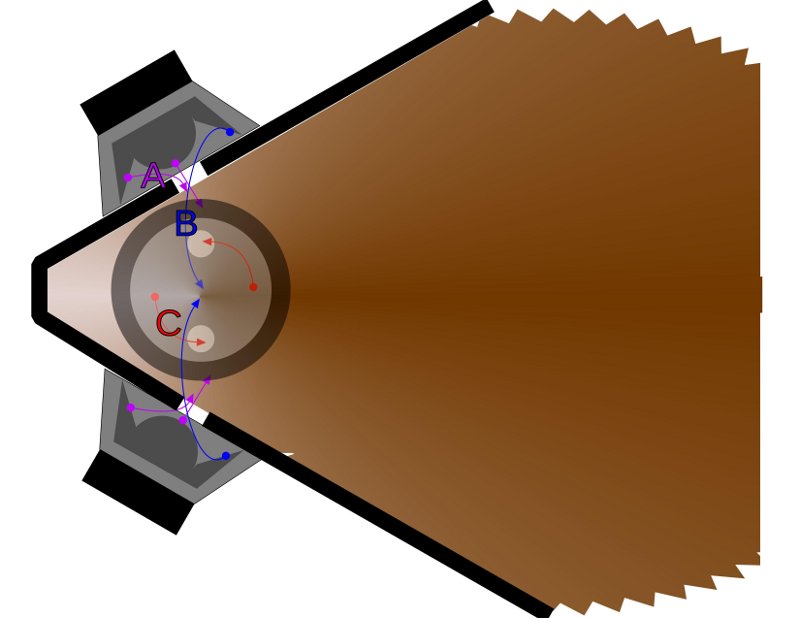
Bill, you've noted that the frequency range of the drivers is the same. I don't think this is true. The sealed back driver has higher efficiency, narrower bandwidth, and a higher F3.
But this is actually a GOOD thing! Because the dipole midranges will play much much lower. For instance, the pathlength from the front of the dipole midranges to the rear of the dipole midranges is about 60cm. That means that there will be a 1/4wl resonance at 140hz.
All of this is academic obviously; but I truly found that my cardioid Synergy horn was probably my BEST sounding Synergy horn that I've ever built. The configuration combines a lower F3 than you'd get with sealed back drivers, with a radiation pattern that's more directional.
The Legis Synergy & PP Tapped Pipe
In case folks may have not seen this build going on in the Subwoofer forum, I think you may be interested in what I think is one of the coolest and biggest Synergies to be built. Monster Massive seems an appropriate name for this implementation using 15 in Deltalites for the mid driver and a 2in JBL for the CD. Pair that with an all new design for a tapped pipe push pull sub using a pair of 18 in drivers, it is massive.
Check it out here:
http://www.diyaudio.com/forums/subwoofers/258706-study-dipole-cardioid-bass-horn.html
In case folks may have not seen this build going on in the Subwoofer forum, I think you may be interested in what I think is one of the coolest and biggest Synergies to be built. Monster Massive seems an appropriate name for this implementation using 15 in Deltalites for the mid driver and a 2in JBL for the CD. Pair that with an all new design for a tapped pipe push pull sub using a pair of 18 in drivers, it is massive.
Check it out here:
http://www.diyaudio.com/forums/subwoofers/258706-study-dipole-cardioid-bass-horn.html
An externally hosted image should be here but it was not working when we last tested it.
An externally hosted image should be here but it was not working when we last tested it.
An externally hosted image should be here but it was not working when we last tested it.
Stig ,Carlsson got good reults from low placed drivers, and ive gotten surprisingly good results from a "joke" 10 minute project with nude tilted Seas tv21's and planar or AMT tweeters, actively crossed over. the tilting is good!Seems to work for Gradient.
Their papers explain it better than I can - you really have to hear them.
Gradient admittedly uses a waveguide with a much broader pattern than mine.
Tipping the waveguide back also does a few other things:
1) The main thing is just making the speaker shorter. I have a 100' projection screen, so I'd really like to keep the loudspeakers below the screen
2) I've been screwing around with Beolab type lenses this year, and it's remarkable how far back you can tip a speaker, and it will still sound good. I don't like the sound of having a speaker firing straight up, but even 45 degrees backwards sounds quite good. (The Beolab uses a lens to redirect the very top octave into the forward lob.)
Haven't tried it with the Summas, but I should.
In case folks may have not seen this build going on in the Subwoofer forum, I think you may be interested in what I think is one of the coolest and biggest Synergies to be built. Monster Massive seems an appropriate name for this implementation using 15 in Deltalites for the mid driver and a 2in JBL for the CD. Pair that with an all new design for a tapped pipe push pull sub using a pair of 18 in drivers, it is massive.
Check it out here:
http://www.diyaudio.com/forums/subwoofers/258706-study-dipole-cardioid-bass-horn.html
An externally hosted image should be here but it was not working when we last tested it.
An externally hosted image should be here but it was not working when we last tested it.
An externally hosted image should be here but it was not working when we last tested it.
Impressive X!
- Status
- This old topic is closed. If you want to reopen this topic, contact a moderator using the "Report Post" button.
- Home
- Loudspeakers
- Multi-Way
- Monster Massive